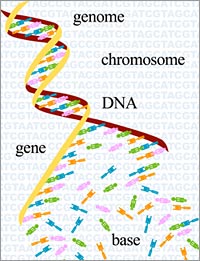
Genetics vs. genomics
The two terms are sometimes used interchangeably. However, genetics usually refers to the study of single genes, while genomics refers to the study of all the genes in a person or organism. The human genome is a person's complete set of DNA.
"Sequencing the genome" is another buzz phrase that has gotten a lot of press
Perhaps you heard the announcement back in April 2003 that scientists at the Human Genome Project "sequenced the entire human genome." Sequencing refers to a detailed description of the order of chemical building blocks of DNA. Human DNA is made up of billions of these building blocks, called bases.
Backtracking for a moment… what is the relationship between DNA, bases, genes, and chromosomes?
The chemical DNA (deoxyribonucleic acid) is in all the cells of our body. It contains chemical building blocks called bases. There are only four bases (A, T, G and C) but they repeat in an ever-changing order throughout our genes. Genes are pieces of DNA that contain instructions for making cells or for what cells do. Each gene contains instructions for building one or more proteins, but a gene can contain millions of bases, so deciphering how it works or what a mutation is can be very difficult. A mutation is a change in the order of the bases in a gene.
Amazingly, genes make up only about 2% of the human genome—the rest are regions that do not make instructions as genes do. It is currently thought that we have between 30,000 and 40,000 genes (only twice as many as a fruit fly). Each gene contains instructions for building proteins, and the genome can be thought of as the complete book of instructions. The genome is not one extremely long piece of DNA, but rather it is divided into separate pieces, called chromosomes. Each chromosome has many genes—between 231 (Y chromosome) and 2968 (chromosome 1). We have 46 chromosomes in 23 pairs. One chromosome in each pair we inherit from our father, and one in each pair we inherit from our mother. We have two nearly-identical copies of every gene, with the exception of those on the "sex" chromosomes, named X and Y. Females have two X chromosomes and males have an X and a Y.
It's the proteins
Actually, it's not the genes that carry out instructions for the body's cells—it's the proteins. Each gene "codes for" or makes a protein or proteins. The proteins do the work in the body. Through these proteins, our genes control how we process foods, detoxify poisons, respond to infections, and the like. Humans can make at least 100,000 different kinds of proteins. Ever heard the word "proteomics"? It's the science of figuring out these proteins.
We are 99.9% the same
Scientists have found that, of the 3 billion or so bases in the human genome, 99.9% are exactly the same from person to person. About 3 million (or 0.1%) are different, and that's what makes us unique. Three million may seem like a big number, but it's not much compared to 3 billion. Scientists now think that there are more genetic differences between people of the same race than between people of different races.
Disease is a result of the interaction between genes and environment
This is true for almost all diseases. The word "environment" encompasses many things. It includes what you eat, your lifestyle and habits (smoking, alcohol use, exercise, etc.), and what chemicals you may have been exposed to (including medications). It also includes your physical environment such as climate or sun exposure and psychological factors such as stress. Environment pretty much includes everything that is not genetic.
Changes or mutations in genes, for the most part, do not cause disease. They influence a person's vulnerability to things in the environment. If we inherit "mutated" genes from our parents, we do not inherit disease—we inherit an increased susceptibility risk for certain diseases. We've all heard of the people that exercised all their life, watched their cholesterol and ate healthy meals—and dropped dead of a heart attack at age 40. We've also heard of the people who smoke, drink, have an unhealthy diet, and live to be 100. Most people fall somewhere between those two extremes.
Most common diseases, such as cancer, heart disease, and diabetes, result from a complicated interaction between several genes and the environment. A few rare diseases (such as Huntington’s or Tay-Sachs disease) are disorders that arise from a single gene and do not appear to have an environmental component. These diseases account for a very small proportion of human disease. Other single-gene disorders are greatly affected by environment, such as hereditary hemochromatosis or PKU.
Many people tend to classify a disease as either genetic or environmental. For example, Uncle Harold smoked all his life and died of lung cancer. Smoking obviously caused his lung cancer. However, only 10-15% of smokers will develop lung cancer. So there must be something else going on—most likely variations in people's genes that either predispose them to getting cancer or protect them from it.
Modified from the University of North Carolina at Chapel Hill, School of Public Health 
|
|
Provides link to non-governmental sites and does not necessarily represent the views of the Centers for Disease Control and Prevention. |
|
|


